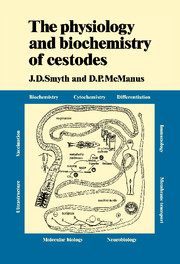Book contents
- Frontmatter
- Contents
- Preface
- Acknowledgements
- 1 The cestodes: general considerations
- 2 The adult cestode: special structural features relevant to its physiology
- 3 The adult cestode in its environment
- 4 The adult: general metabolism and chemical composition; lipid metabolism
- 5 The adult: carbohydrate metabolism
- 6 The adult: proteins and nucleic acids
- 7 The biology of the egg
- 8 Developmental biology of larvae
- 9 Development within definitive host
- 10 Cultivation of cestodes in vitro
- 11 Immunobiology of cestodes
- References
- Index
8 - Developmental biology of larvae
Published online by Cambridge University Press: 24 November 2009
- Frontmatter
- Contents
- Preface
- Acknowledgements
- 1 The cestodes: general considerations
- 2 The adult cestode: special structural features relevant to its physiology
- 3 The adult cestode in its environment
- 4 The adult: general metabolism and chemical composition; lipid metabolism
- 5 The adult: carbohydrate metabolism
- 6 The adult: proteins and nucleic acids
- 7 The biology of the egg
- 8 Developmental biology of larvae
- 9 Development within definitive host
- 10 Cultivation of cestodes in vitro
- 11 Immunobiology of cestodes
- References
- Index
Summary
General account
Problems of special physiological interest in larval development include those related to: (a) entry into intermediate hosts, (b) migration to the site(s) of development within these hosts, (c) the physiological and biochemical changes taking place during the passage from the external environment into the intermediate host, or – in the case of more than one intermediate host – those taking place on transference from one intermediate host to another. These problems are clearly interwoven with the ecological relationships between definitive and intermediate host(s). For example, if the first intermediate host of a pseudophyllid cestode is a freshwater copepod, it can be assumed that: (a) the free-swimming coracidium will be osmotically adapted to fresh water and low temperatures; (b) in the copepod host, it will still be adapted to freshwater temperatures but now osmotically adapted to the copepod haemocoele; (c) in the second intermediate host (normally a fish), the osmolarity adaptation will have changed again (but not the temperature adaptation); (d) if the defintive host is a bird or mammal, further adaptations in the the osmolarity and temperature tolerance will occur. Associated with these physiological changes, of course, will be the related switching on and off of the appropriate enzymes adapted to the internal environmental conditions in the host concerned and, probably, major respiratory changes.
- Type
- Chapter
- Information
- The Physiology and Biochemistry of Cestodes , pp. 195 - 231Publisher: Cambridge University PressPrint publication year: 1989



